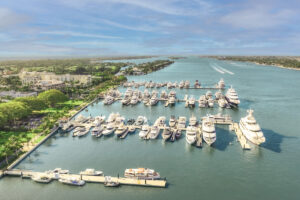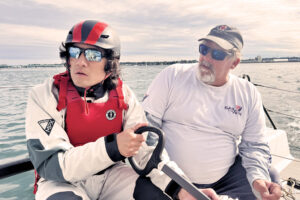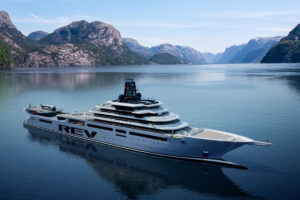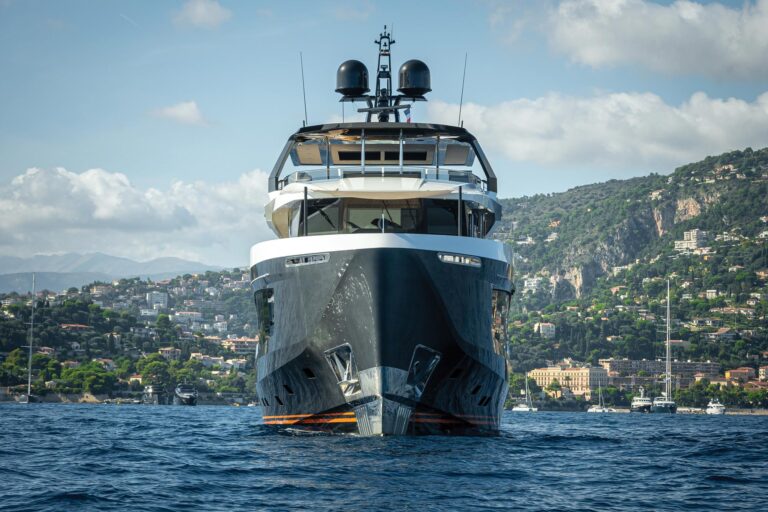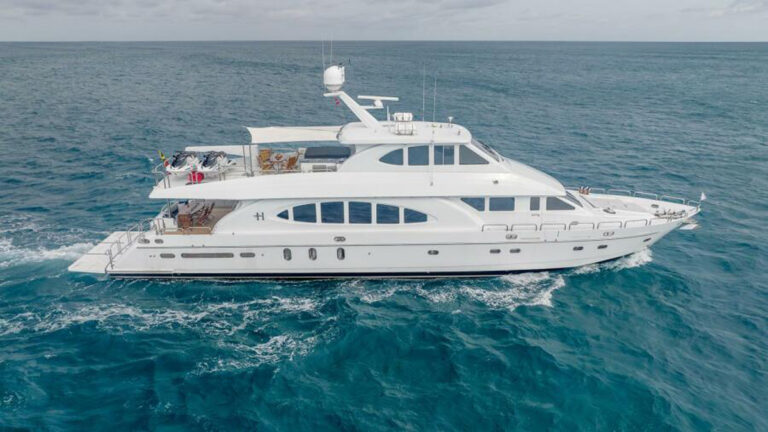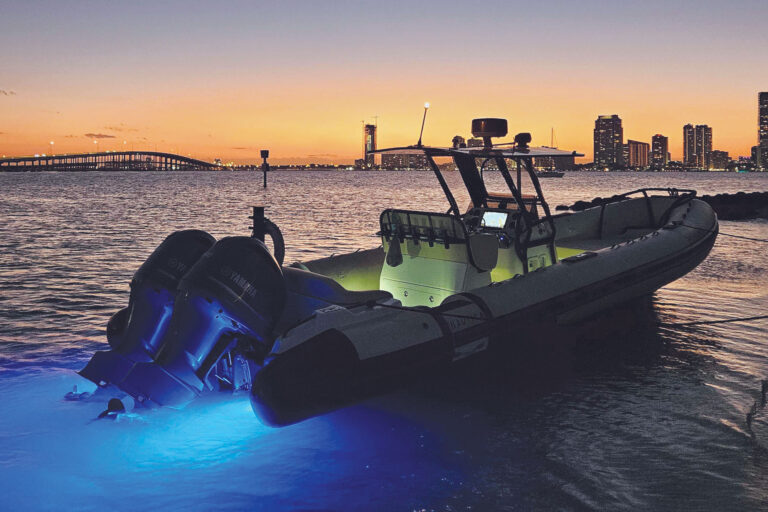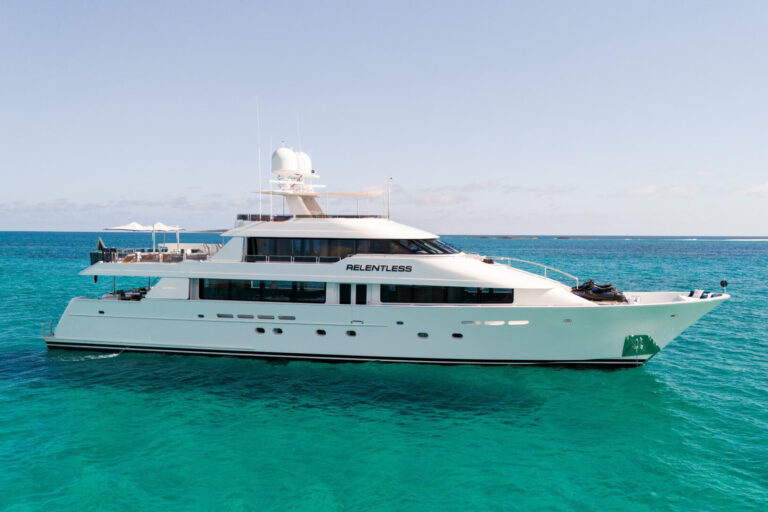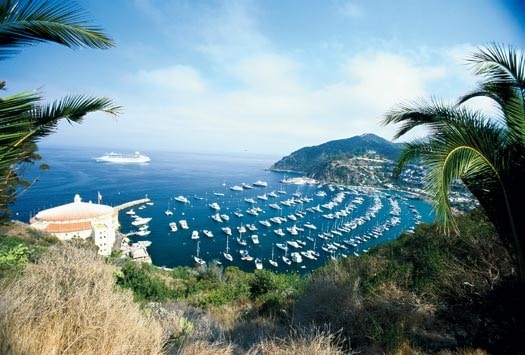
yachting/images/magazine/2007/032007/fea_catalina_525x355.jpg
As a youngster, I always thought of Catalina as an island of dreams. On visits, I’d take our tender and row around the moorings, just looking at the yachts. There were movie stars to be seen on their boats, because Catalina was just an annex of Hollywood. Bogey and Bacall were already gone, but David Niven liked to drink champagne in his cockpit and Buddy Ebsen was always aboard his racing sloop. Other regulars included Jimmy Cagney, Tyrone Power and Sterling Hayden.
John Wayne was the best, though. He could often be spotted leaning on the railing of his converted minesweeper having a smoke. As I rowed past, almost invariably he’d growl down in his gravelly voice, “Hey, kid, how ya doin’?”
Starstruck though I was, it was the boats that I really loved: vintage Chris-Crafts with rows of portholes, varnished Stephens motoryachts, a gracious fantail Trumpy or a racy Huckins. I dreamed of the day that I would come here on one of my own.
My dream came true over the years, but never so sweetly or glamorously as when we slid into Avalon aboard the new Renzo Express 4.0. With its retro-classic portholes and ageless lines, it easily attracted attention from the seen-it-all eyes of the harbor patrolman as he pointed us to a mooring. “Really nice boat,” he growled. My toes curled with pleasure; had he added, “kid,” I might have fainted.
But I get ahead of myself. This whole dream trip started with an invitation from Renzo Rivolta, the man himself. Would I like to take his new Express 4.0 to explore Catalina? Need it be said that I jumped at the chance? For an island wreathed in myths and legends, its main harbor’s name synonymous with the nether regions where King Arthur allegedly was buried, what could be better than this Italian-styled modern classic with luxury to spare and speed to burn?
We cast off from Lido Marina in Newport Harbor on a foggy Southern California morning, sliding quietly down the long bay where an empty lot can bring as much as $2,000 a waterfront inch. Past the ageless Balboa Pavilion, past rowing shells being coached by barking coxswains and out the jetty into a gray and seamless haze.
The throttles went forward, with big swells but smooth water, and soon we were running at a steady 25-plus knots, with our companion Renzo PT Runner hanging off our port quarter like a blue navy jet in formation. There was no horizon, no discernible clouds, just a bowl of gray.
Suddenly we were enveloped by a huge school of dolphin that were clearly looking for some fun. They cavorted in our bow and stern waves, zipped across our bows, did flips in the air and tacked through our wake as though urging us to come play. After a few minutes, they tired of our unwillingness to break off course and sped off in search of more fun companions.
Just as we started to think that we’d overshot Catalina, a bulk of granite mountains reared up from the haze. Soon our GPS course was verified (none of us really trusts black boxes) as the island’s most important landmark, the red-roofed white columns of the Casino in Avalon, appeared in the mist.
Decades of tourists have thought the Casino was a Pacific version of Monte Carlo, but it was never for gambling (that was the province of ships anchored offshore from the 1920s to the ’40s). No, this casino once was a huge dance hall and theater and, for years, big band sounds beamed across America by radio to remote farms and big city penthouses “from the beautiful Casino on Catalina Island.” America paused to listen as Glenn Miller, the Dorsey brothers, Harry James and Artie Shaw drove dancers wild. The wooden dance floor, still in place and still used, echoed as dancing feet-sometimes as many as 3,000 couples!-tapped out the Lindy, the Charleston and, of course, the Balboa.
More important to skippers, however, is that its 12-story white deco walls can be seen from the mainland on a clear day. It was somehow appropriate that we arrived as Avalon was shrouded in mist, much like the mythical Avalon was shrouded as the resting place of King Arthur. And, like that tale, there is something very magical about Avalon. The red-roofed houses climb the hillsides around the yacht harbor like a small Italian village, colored with bougainvillea blooms against whitewashed walls. Shops, restaurants and hotels elbow each other for space on the wide promenade around the waterfront.
We picked up our mooring near the pier and the water taxi whisked alongside, with the skipper neatly stopping exactly next to our cockpit and two inches from our pristine hull. It turned out to be $4.75 to go 100 feet to shore, but it was probably worth it for his skill in not dinging our boat.
Lunch was a casual affair at the Channel House overlooking the bay, sandwiches and iced tea all around as we watched the crowds pass by. Many were from the huge Carnival cruise ship anchored just offshore, where the seaplanes once landed from the mainland. Shoreboats gushed tourists by the thousands, who walked the promenade and eyed the brightly colored tiles that have been a Catalina trademark.
Sitting comfortably in the late afternoon sun on a beachfront bench, I looked high on Mt. Ada to the old Wrigley mansion, once home to the chewing gum heir, William Wrigley Jr., when he presided over winter training for his beloved Chicago Cubs. Now an ultra-luxe hotel, it isn’t inexpensive, but it does have the best view on the island. Nearby is Holly Hill House, a Victorian witch’s hat sitting on a hillside, but my favorite is the Zane Grey house, which hasn’t changed since the famed Western writer pounded out his horse operas for an adoring audience. Now a hotel filled with his memorabilia, it overlooks the Tuna Club, one of the earliest sportfishing clubs and one that set angling standards for years to come.
The high mountains around the harbor make for an early twilight, so we adjourned to Steve’s Steaks on the waterfront to savor big slabs of tender beef. There we discovered a great wine (Isoceles, from Justin Vineyards) and lingered over arguably the best crème brà»lée I’ve ever had (and I count myself an international expert).
Sitting on Steve’s second floor overlooking the harbor as it turned blue with dusk and lights flickered in the hillside villas, we realized that Jeff Brown, our host from JK3 Nautical Enterprises in San Diego, had turned on the underwater lights of the Renzo before we came ashore; now they blazed out a blue-white glow that marked us in the anchorage.
Unlike the previous day, morning dawned bright and clear and we were quickly underway, heading out past the casino and noting that snorkelers were already working the protected seabed just off the casino, where the big goldfish and groupers get up even earlier than we did. It wasn’t long before we were off Toyon Bay, named by the original lessee Toyon Yacht Club (spell it backwards to learn why boat ownership wasn’t required to be a member).
But Toyon is more memorable, in my mind, at least, as a base of training for the Office of Strategic Services during WWII. The OSS was the predecessor to the CIA, and it was in this quiet cove, and on the rugged hills nearby, where young Americans learned to use their cloaks and daggers. Many were shipped directly behind the lines in Italy, Sicily, Corsica and the Greek isles, all countries whose geography resembled Catalina’s. I wondered, as we cruised these peaceful blue waters, how many returned to see them again.
Our first stop was Buffalo Beach, the San Diego Yacht Club outstation at White’s Landing, for a Kodak photo moment in front of the palms and palapas. Kids were back in school, so the moorings were deserted; the water was crystal clear and fish darted about in huge schools. Sharing White’s was a Boy Scout camp, also quiet until summer’s teenage commandos hit the beach.
At the Newport Harbor Yacht Club outstation in nearby Moonstone Cove, we stopped again for photos with the uniquely Catalina mix of sandy beach, palm trees and rugged cliffs as a backdrop. Our last stop was Two Harbors, better known to Southern California skippers as The Isthmus, a cinching of Catalina’s waist that makes two great protected harbors: one on the lee side, another on the rugged windward side. Indentations around these main harbors create quiet coves, some private, some public, but all fairly untouched except for simple shoreside facilities.
The Isthmus was where Treasure Island was filmed, where Clark Gable strode the afterdeck as Fletcher Christian in Mutiny on the Bounty and where Errol Flynn swung through the rigging in The Sea Hawk. Today, the beaches and palms give the effect of being far away in the South Seas, yet Catalina is still (as the song says), just “twenty-six miles across the sea” from metropolitan Southern California.
As we discovered on our dream cruise, the real attraction of Catalina is that you can make it what you want. It can be a good dinner ashore in Avalon, it can be snorkeling over a bed of gently waving kelp, or it can be a warm afternoon sprawled in the cockpit with a good book.
As the day wound down, time was running out on our dream cruise. It was time to head back down the island, stopping at Avalon to drop off friends who were catching the ferry back to the mainland, and then turn the graceful bows of the two Renzos toward San Diego.
Looking back at Avalon in the blue twilight, it isn’t hard to imagine yourself in other times. When big band music is floating across the harbor, you wonder if Humphrey Bogart is slipping on his tuxedo for an evening ashore with Lauren Bacall. Is Zane Grey up in his Indian-styled house, rolling another sheet of paper into his typewriter or planning his next fishing expedition? Farther along the island, in a cove marked only by the rustle of the palms and the gentle shush of water on the sand, you might be anchored off a South Seas atoll. Or slipping ashore, face blackened by grease, knife in hand as you approach that “German” sentry In the romance that is Catalina Island, you can be what you want to be. r
Contact: Renzo Yachts; www.renzoyachts.com

